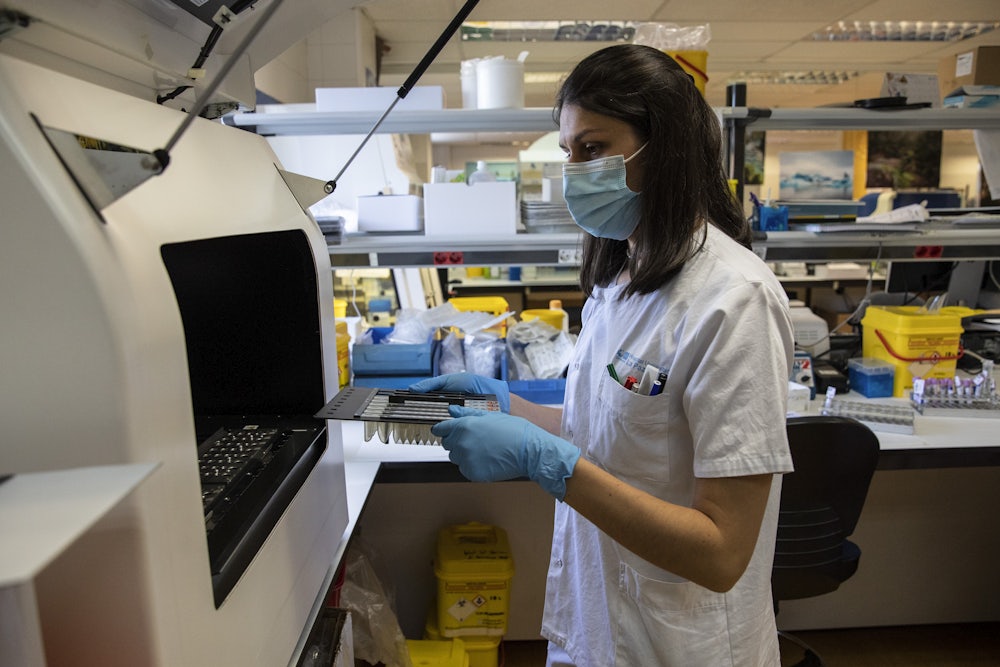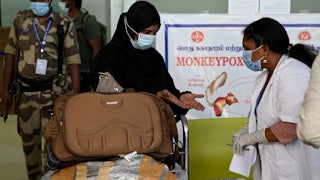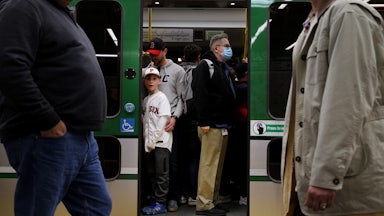There’s a kind of cruel irony in the current run on monkeypox vaccines. Dutch researchers testing polio vaccines were the first to discover the disease among monkeys in 1958. The vaccination drive to eliminate smallpox was what uncovered the first monkeypox case among people, in the Democratic Republic of Congo. That vaccination campaign went on to become the premier example of vaccine success—to this day, smallpox is the only disease eradicated among humans by vaccines. In every way, the history of monkeypox is inextricable from vaccines.
But that shared history also comes with benefits. One of those is the vaccines themselves: The vaccines for smallpox also work against other poxviruses, including monkeypox. And another is a lesson about what a winning strategy looks like: Arguably, the most successful vaccination campaigns are intense but limited in scope, because they curtail the outbreaks and then resources can be turned to other threats.
“The public should not be freaking out,” Dr. Saad Omer, director of the Institute for Global Health and a vaccine researcher at Yale University, told me, regarding the monkeypox situation. But “public health people should be paying attention and getting their act together.” And the more our leaders and experts take monkeypox seriously now, he said, “the less likely [it is that] the rest of the country will have to freak out about it eventually.”
The most important thing right now is not to fumble the lead we have with monkeypox. There have been more than 2,100 cases reported in 42 countries so far, and the outbreak isn’t close to ending. “This is likely to expand—that would be the least surprising thing,” Omer said. Even if all cases were known and accounted for today—an unlikely event, given limitations on testing and monitoring—there would likely be onward transmission detected from the known cases.
But this is still a relatively small outbreak, and not everyone needs to get vaccinated at this point. The vaccines aren’t particularly pleasant to get, and we have limited stock. The United States has in stock 72,000 doses of Jynneos, the vaccine approved for monkeypox and smallpox, with another 500,000 doses ordered. They’re best deployed to the places and people who need them the most.
“We have to have a really clear plan about prioritizing vaccines and therapeutics—who’s going to need them, how they work for people, what the plan is going to be to do this,” Dr. Anne Rimoin, a professor of epidemiology at the UCLA Fielding School of Public Health, said at an event on monkeypox hosted by Yale.
One major bottleneck is testing. Ring vaccination, which some countries are now employing, works by vaccinating close contacts of confirmed cases. But vaccines can’t be given to close contacts if we don’t know who the patients are.
Monkeypox tests are very limited in the U.S., with local jurisdictions sending suspected samples to the Centers for Disease Control and Prevention for confirmation—a long, arduous process that is likely catching only a fraction of current cases. “If you’re staring into the dark, you might not see anything. If you shine a flashlight, you’re going to catch something. But if you turn all the lights on, you’re going to see a lot more,” Rimoin said. “You need diagnostic capacity, and right now, we’re very hampered by this diagnostic capacity.”
The logistics of deploying the vaccines we have also involve an enormous amount of work. The CDC’s independent Advisory Committee on Immunization Practices ought to begin making potential plans for vaccinating wider swaths of the population now. “We should have, soon, a discussion at the ACIP level, mapping out some of those scenarios,” Omer said. “We should build a button, but not press it.”
Officials need to plan not just for the logistics of delivering vaccines to those at risk around the country and the world but also for the questions people have about the necessity of the vaccines and their side effects. After all, with Covid-19, it has taken far longer to convince some people to get vaccinated than it did to create, study, and authorize the vaccines.
“It wasn’t [developing] the vaccine that was your bottleneck; it was vaccination that was the bottleneck. Prepare your behavioral response, see what messaging you will do, get your advice ready,” Omer said. People already have unanswered questions about monkeypox and its vaccines, an uneasy parallel to issues he saw developing early in the Covid pandemic. Yet “we haven’t learned a bit from Covid-19 in terms of behavioral response,” he said. To avoid that with monkeypox, he recommends deploying a public relations strategy immediately: “Start testing those messages now.”
Transparency and monitoring of side effects will be particularly important in addressing vaccine concerns. The Jynneos vaccine, which looks to be about 85 percent effective against monkeypox, was approved based on animal studies and limited studies in humans. So far, it has been rolled out among certain populations, like members of the military and some laboratory researchers, with no apparent safety concerns.
“I think the benchmark that they used was reasonable,” Omer said of the vaccine trials. “So far, the safety record has been reasonable. But we need to again weigh the need versus the side effects.” The Jynneos vaccine doesn’t leave a scar like the earlier pox-family vaccine that was widely used against smallpox does, but it can be unpleasant to receive—with redness and swelling at the injection site alongside fever, fatigue, nausea, and chills. There is also little data on vaccination during pregnancy, although some countries, like the U.K., have begun vaccinating pregnant people during this outbreak, given the risks of contracting monkeypox during pregnancy and no adverse effects in animal trials. In addition, the vaccine isn’t approved for children under the age of 18, and it has not been studied well in this population.
The vaccines currently being administered “should come with a robust postmarketing surveillance program” for effectiveness and safety in a wider population, Omer added. With the earlier smallpox vaccine, pericarditis and myocarditis soon emerged as potential side effects—in fact, that’s one of the reasons researchers looked for these conditions after Covid vaccination. So far, the very rare side effect doesn’t seem to have been detected with the later smallpox vaccines, but monitoring those who receive them now could help understand the vaccines’ safety profile.
Those results should be published as quickly as possible. Publishing research like this during the Covid pandemic has been regrettably slow, Omer said. “We publish the results when the horse has not only left the barn, it has come back to the same barn.”
There is a bright spot of news: The immunity from smallpox vaccines appears to last for years, even decades, and the virus mutates very slowly, which means those who are vaccinated will likely be well protected. But it’s not clear if a booster is needed to protect against monkeypox among those who were vaccinated against smallpox years ago; more research is needed on that.
That’s a common refrain. Most of the research on monkeypox itself was done in the 1980s, soon after the virus was identified in people. Back then, the field of public health was optimistic that humankind was exiting the era of infectious diseases. We had discovered incredibly effective ways to beat them back, from vaccines to outbreak monitoring and tracing, and the future could only get brighter with new technological innovations and vast improvements to health, scientists reasoned.
That, of course, didn’t happen. (It’s just one way in which simply having the tools doesn’t solve disease outbreaks.) While early monkeypox researchers assumed the virus would simply fade away, much has changed since then—the ways people interact with animals and the environment and the ways health care is delivered, as well as waning population immunity once vaccinations against smallpox weren’t needed anymore. When Rimoin and her colleagues set out to understand monkeypox outbreaks better in 2010, they saw an “incredible” and unexpected increase in detected cases.
“We pay the price every single time that we don’t invest in disease surveillance,” Rimoin said. “As my late father-in-law used to say, it’s much easier to stay out of trouble than it is to have to get out of trouble.” Or, as she put it: “You pay now or you pay later.”
The good news is “this isn’t a mysterious virus that we hadn’t identified before,” Rimoin said. “This is a known pathogen that did exactly what we predicted it could potentially do.” But as monkeypox spreads in previously undocumented ways, “we need to go further so that we truly do understand it, so we can get in front of it, because the stakes are frankly very high.”
Her greatest concern now is that monkeypox will spill over into animals in the countries where it is now spreading and then continue circulating and spilling back into humans for years to come. That could mean monkeypox vaccines need to be deployed more, which would take significant resources, Rimoin said. “It’s an enormous step backward for public health to have to really reconsider utilization of smallpox vaccine again.”
In outbreak disaster movies, the arc ends at the triumphant discovery of a vaccine. The day is saved; the conclusion is inevitable; the credits roll. “We know in real life the story is a little bit more complicated,” Omer said.
The existence of a vaccine is just the start; rolling it out, deciding who needs it and where is its own complicated narrative. That work must begin now, in order to stay ahead of an outbreak that is still growing and in order to maintain trust in vaccines and in public health in general. The stakes are high.










